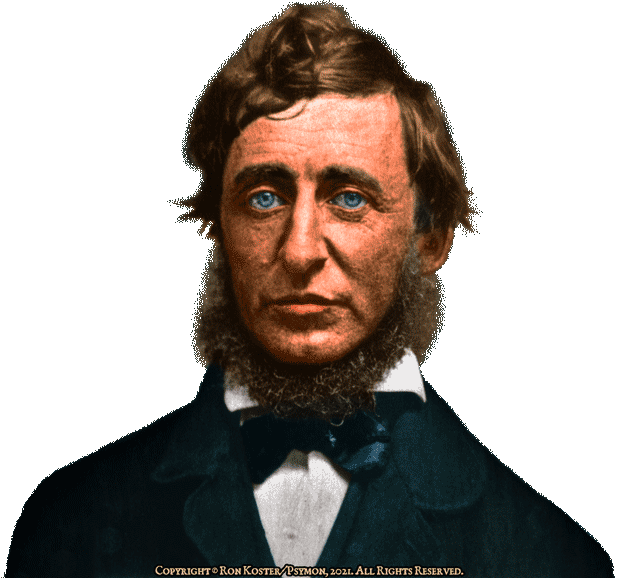
Who was Henry Thoreau?
A Short Introduction
by Ann M. Woodlief

Henry David Thoreau was a complex man of many talents who worked hard to shape his craft and his life, seeing little difference between them. Born in 1817, one of his first memories was of staying awake at night “looking through the stars to see if I could see God behind them.” One might say he never stopped looking into nature for ultimate Truth.
Henry grew up very close to his older brother John, who taught school to help pay for Henry’s tuition at Harvard. While there, Henry read a small book by his Concord neighbor, Ralph Waldo Emerson, Nature, and in a sense he never finished exploring its ideas — although always definitely on his own terms, just as he explored everything! He and his brother taught school for a while but in 1842, John cut himself while shaving and died of lockjaw in his brother’s arms, an untimely death which traumatized the 25 year old Henry. He worked for several years as a surveyor and making pencils with his father, but at the age of 28 in 1845, wanting to write his first book, he went to Walden pond and built his cabin on land owned by Emerson
While at Walden, Thoreau did an incredible amount of reading and writing, yet he also spent much time “sauntering” in nature. He gave a lecture and was imprisoned briefly for not paying his poll tax, but mostly he wrote a book as a memorial to a river trip he had taken with his brother, A Week on the Concord and Merrimack Rivers.
After two years (and two months), Thoreau returned to Concord — a bare two miles away which he had visited frequently during his stay at the pond, having completed his experiment in living and his book. Unfortunately, few people were interested in purchasing his book, so he spent the next nine years, surveying and making pencils at times but primarily writing and rewriting (creating seven full drafts) Walden before trying to publish it. He supported himself by surveying and making a few lectures, often on his experience at Walden pond.
Many readers mistake Henry’s tone in Walden and other works, thinking he was a cranky hermit. That was far from the case, as one of his young neighbors and Edward Emerson attest. He found greater joy in his daily life than most people ever would.
He traveled often, and his excursions resulted in lectures and his travel books, The Maine Woods, Cape Cod, and A Yankee in Canada, all published posthumously. Other projected books in manuscript and his journal were published by Bradley Dean, namely, Faith in a Seed  (1993) and Wild Fruits (1993) and Wild Fruits  (2000). He was fascinated by the frontier, as seen in his essay on Walking, and in Native Americans, which he planned to write about. He opposed the government for waging the Mexican war (to extend slavery) eloquently in Resistance to Civil Government, based on his brief experience in jail; he lectured against slavery in an abolitionist lecture, Slavery in Massachusetts, and he even supported John Brown’s efforts to end slavery after meeting him in Concord, as in A Plea for Captain John Brown. (2000). He was fascinated by the frontier, as seen in his essay on Walking, and in Native Americans, which he planned to write about. He opposed the government for waging the Mexican war (to extend slavery) eloquently in Resistance to Civil Government, based on his brief experience in jail; he lectured against slavery in an abolitionist lecture, Slavery in Massachusetts, and he even supported John Brown’s efforts to end slavery after meeting him in Concord, as in A Plea for Captain John Brown.
Thoreau died of tuberculosis in 1862, at the age of 44. His last words were said to be “Moose” and “Indian.” Not only did he leave his two books and numerous essays, but he also left a huge journal, published later in 20 volumes, which may have been his major work-in-progress. Many memorials were penned by his friends, including Emerson’s eulogy and Louisa May Alcott’s poem, Thoreau’s Flute.
Over the years, Thoreau’s reputation has been strong, although he is often cast into roles — the hermit in the wilderness, the prophet of passive resistance (so dear to Mahatma Gandhi and Martin Luther King) — that he would have surely seen as somewhat alien. His work is so rich, and so full of the complex contradictions that he explored, that his readers keep reshaping his image to fit their own needs. Perhaps he would have appreciated that, for he seems to have wanted most to use words to force his readers to rethink their own lives creatively, different though they may be, even as he spent his life rethinking his, always asking questions, always looking to nature for greater intensity and meaning for his life.
Copyright © Ann M. Woodlief, 2014.
Used with permission from American Transcendentalism Web.
www.transcendentalism.org 
❦
Questions? Comments? Bug report?
☞ Contact Me! ☜
❦
Acknowledgements
All original text, graphics and web deisign of this entire site
are copyright © Ron Koster/Psymon, 2021 (except as otherwise noted)
and may not be reproduced or distributed in any manner
without explicit permission.
See: A Note on Copyright.
All Rights Reserved.
|





